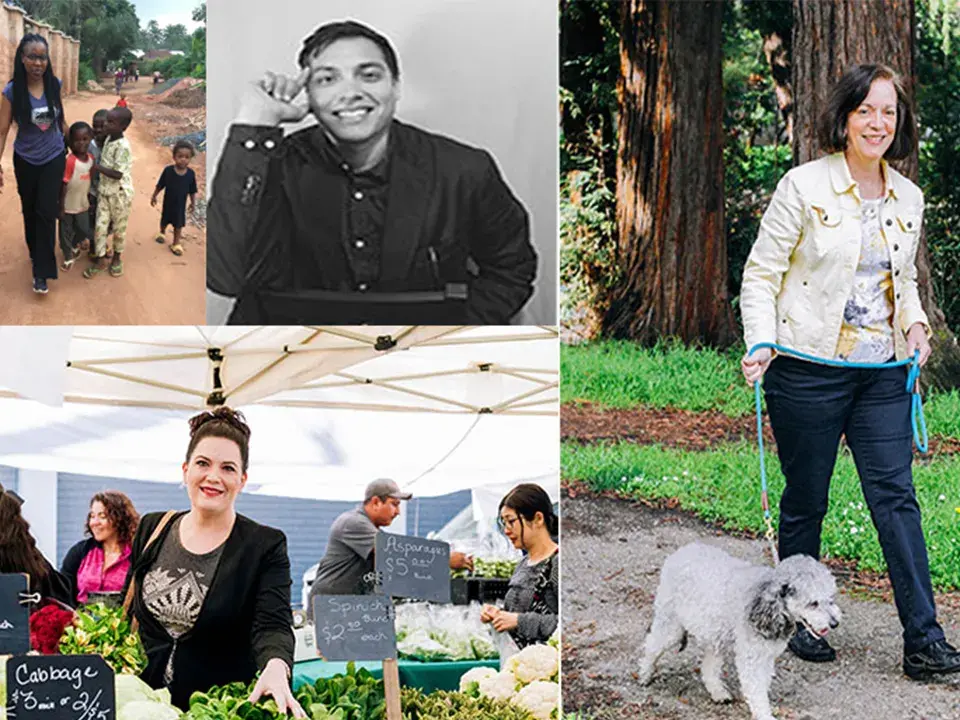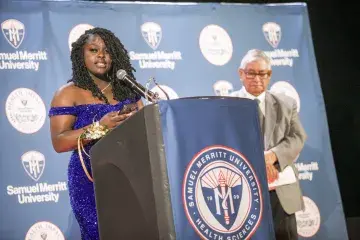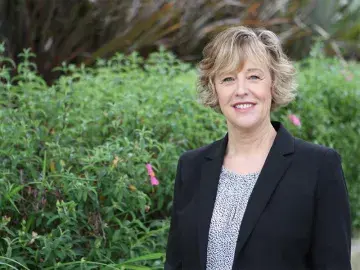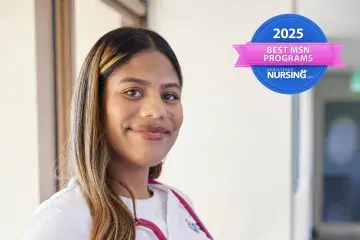Student Success

At SMU, student success is about more than grades. It’s about what students do with their education once they leave the classroom to help fulfill our nation’s pressing need for healthcare practitioners who will improve the health and well-being of our communities. These high-achieving alumni exemplify what can happen when students apply their knowledge to meet significant healthcare challenges. Each of these graduates’ stories proves the value of putting passion to work in improving people’s lives.
***
Uzoma Uwakah ’15 started the Doctor of Nursing Practice program a month after she lost her brother — her “best friend and soulmate” — to gun violence.
“It was probably what saved me after my brother died,” she says. “It kept me inspired and gave me hope.”
When Uwakah considered a subject for her final project, she went back to her roots. She set her sights on reducing the high rates of neonatal mortality in rural Nigeria, the birthplace of her parents. There she trained midwives in cardiopulmonary resuscitation for newborns.
That work didn’t end with her graduation. Despite a full-time job as a surgical nurse at San Francisco General Hospital, Uwakah took the reins of the foundation her father created to address maternal healthcare in memory of his mother who died while giving birth.
Now the executive director of the Uwakah Memorial Medical Foundation, she works to provide resources to a clinic in the rural village where her father was born and where many of the residents are small farmers who can’t afford healthcare supplies.
She started by donating 100 kits containing healthcare materials necessary for successful childbirths including mats, gloves, soap and rope to tie off the umbilical cord. Later she raised funds to build a concrete wall around the clinic to provide security.
Uwakah’s hope is to continue improving the clinic so women will seek services there and to eventually partner with other clinics.
“I love what I do,” she says. “I don’t separate what I do from my passion. They’re the same."
***
When Amy Stevenson ’15 (ELMSN) was a graduate student in nursing, she and two fellow students introduced a nutrition program at a residential hotel in San Francisco’s Tenderloin neighborhood as part of her community health course.
The effort won Stevenson and Jennifer Lee the prestigious Albert Schweitzer Fellowship that enabled them to expand their efforts to other hotels and to introduce the low-income residents to the health benefits of shopping at farmers’ markets.
“I really find it most rewarding to work with patients who are marginalized in some way,” she says. “The experience from my clinical rotations really gave me the tools to engage with my patients.”
Now a manager in the Case and Disease Management Department at the Alameda Alliance for Health, Stevenson works with patients with complex medical needs who face economic and social barriers by helping them navigate the healthcare and insurance systems so they can improve the quality of their lives.
“When you see the everyday stressors they live with in high-crime, low socio-economic areas as well as having to deal with chronic medical conditions, the combination can be really debilitating,” says Stevenson.
Stevenson, a student in SMU’s Doctor of Nursing Practice program, is overseeing a pilot program designed to more effectively connect high-risk patients to community resources like housing and substance abuse treatment while coordinating care between hospitals, providers, and behavioral health services.
***
During his four years at the California School of Podiatric Medicine (CSPM), Roberto De Los Santos ’18 became more than a physician. He turned into an ubervolunteer.
A list of his community service engagements and student leadership positions since he started the rigorous medical program is extensive. It includes working at homeless shelters, for the Special Olympics, and as an SMU President’s Ambassador.
“I really wanted to get to know the local community,” says the Houston native. “I was essentially trying to make a connection with people.”
For the past three years, De Los Santos participated in CSPM’s annual medical mission to the Mexican border town of San Ysidro, which hosts the nation’s busiest border crossing. A Spanish speaker, he served as an interpreter and contributed his medical expertise on an interdisciplinary team of students and faculty clinicians who performed foot and ankle evaluations while also conducting health screenings for diabetes and vascular disease.
De Los Santos credits his mother for introducing the value of volunteerism in his life. Every year at Christmas, his family distributed toys to disadvantaged children. Though De Los Santos is about to embark on a challenging residency program in Texas, he plans to continue community service and hopes to lead medical missions abroad in the future.
“Volunteering is who I am,” he says.
***
Rachel Sutter-Leve ’18 was trained in classical ballet as a child. When injuries to her hip and back threatened to get in the way of her dancing, she turned to physical therapy.
“I credit my ability to continue dancing recreationally to the incredible care I received from physical therapists who were able to keep me healthy,” says Sutter-Leve, who majored in contemporary dance in college.
Now that she is becoming a physical therapist (PT), Sutter-Leve is committed to helping other dancers cope with injuries that can result from such a demanding athletic activity. She knows from personal experience the strain from back extensions and other repetitive stress injuries that come with ballet.
For a clinical rotation earlier this year, Sutter-Leve chose to work with young dancers at the Sports Medicine Center for Young Athletes at UCSF Benioff Children’s Hospital Oakland.
In her spare time, she volunteers at the Healthy Dancers’ Clinic at ODC Dance in San Francisco where many of the professional performers lack health insurance and need guidance on injury management and recovery.
Sutter-Leve, a member of the Performing Arts Special Interest Group of the American Physical Therapy Association, says she would like to work with performing artists on a national level.
“It’s been so rewarding to help young people stay healthy and do what they love,” she says. “I received incredible care from PTs and now it’s nice to be on the other side.”
***
Camille Gonzales ’16 was exposed to multiple healthcare settings and experienced a variety of patient populations while she was an occupational therapy student. Yet her heart was set on landing a position in mental health after graduation.
Now working at John George Psychiatric Hospital in San Leandro, Gonzales provides inpatient therapy to patients of all ages with diagnoses ranging from depression and bipolar disorder to substance abuse and schizophrenia. She runs wellness groups to promote coping skills, socialization, and the ability to perform activities of daily living such as hygiene and other self-care.
In a lesson she learned at SMU, Gonzales says collaborating with other healthcare providers is the most effective way to treat and stabilize acute psychiatric illness. That lesson is reinforced for her every day by working on an interdisciplinary team of mental health specialists, nurses, pharmacists and psychiatrists that shapes the course for each patient. Her role is to report patients’ behavior, including how they are responding to treatment, their ability to socialize, and what discharge setting is most appropriate for their cognitive functioning level.
People who find out that Gonzales works at a psychiatric hospital often ask her whether she feels safe, a reflection of the social stigma surrounding mental illness. But the truth is she is not afraid and has never been more excited about going to work.
“This is the most rewarding work I’ve done,” says Gonzales.
***
Much has changed for Rachel Mathison ’18 since she enrolled in the RN to BSN program. She was promoted to a management position in the neonatal intensive care unit at Kaiser Permanente in Oakland and presented her community health projects at two national forums.
“The program gave me tools to be more of a leader,” she says. “I always was a person who wanted to make positive changes at work, but it gave me the skills to be a more effective communicator.”
Mathison put into action what she was learning in class when she noticed a young boy with gray teeth during her public health clinical rotation. She did some research and discovered that tooth decay is the most common childhood disease in the nation, particularly impacting kids in underserved communities.
Along with two other SMU nursing students, Mathison developed an oral hygiene education campaign for public school students, which they presented at last year’s Clinton Global Initiative University.
Mathison also presented information about safe sleep practices for infants at the Institute for Healthcare Improvement’s national forum.
After 20 years working in neonatal intensive care, her educational experience has shifted her focus to supporting her team.
“I really think there’s an art to being a nurse leader,” she says.“As a manager, I want to care for the caregivers.”
***
Judith Nolan ’16 already had a doctorate in anatomy and 13 years of experience in the pharmaceutical industry before her love of medicine won out and she enrolled in SMU’s Accelerated Bachelor of Science in Nursing program.
“There’s so much you can do with nursing because it’s so open,” she says.
During a clinical rotation in 2016, Nolan helped to educate senior citizens about staying fit and how to manage their health risks so they can maintain their independence and quality of life.
Because of Nolan’s previous experience as a research scientist, two SMU faculty members asked her to join them in leading a workshop at this year’s American Society on Aging conference in San Francisco on creating a wellness program at a senior living facility that provides residents with physical and psychosocial benefits.
“I had some of the most rewarding experiences with patients I’ve had in my entire career,” she says of her clinical rotations.
Nolan, who believes prevention is the future of medicine, is now studying to become a family nurse practitioner at SMU while working as a full-time nurse educator at a psychiatric hospital where she is responsible for all of the training of clinical staff.
“Mental health is not paid as much attention to as it should be,” she says. “You can’t be physically healthy without mental health.”
This article appeared in the 2018 Report to the Community. Click here to view the entire annual report.
Photo caption: (counterclockwise from left) Uzoma Uwakah, Roberto De Los Santos, Judith Nolan, Rachel Mathison.


